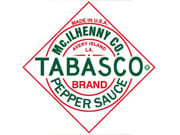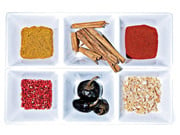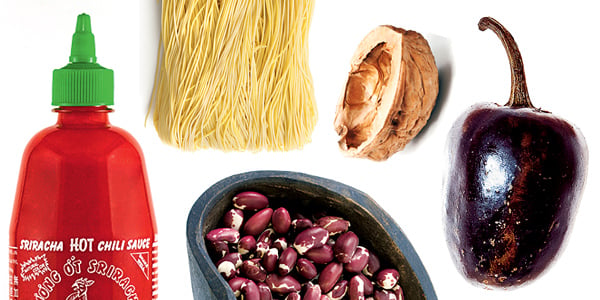It’s a lot easier to get creative in the kitchen—or to bang out a quick dinner—when you have a well-stocked pantry. And those dusty old spices don’t count. Here are some items worth having on hand. Unless otherwise specified, ingredients are generally available in grocery stores.
Anasazi beans
These speckled beans from the Southwest have a nutty sweetness and, unlike other dried beans, don’t require soaking. They’re good for chili, soup, and refried beans and are sold at most Whole Foods stores.
Canned tomatoes
Nearly every chef we talked to agrees that whole San Marzano tomatoes are the best.
Carnaroli rice
Teddy Diggs of Ripple likes short-grained varieties such as carnaroli for more than just risotto—he uses them in Asian dishes, too. The rice becomes creamy but retains a good bite. Available at Whole Foods, the Italian Store in Arlington, and Three Brothers Italian Market in Bladensburg.
Chicken stock
It’s true that this broth, essential for many sauces and soups, is best made at home. But if you don’t have time, we like the Imagine brand (preferably low-sodium), available at Whole Foods.
Chipotle in adobo sauce
Available canned at most grocery stores, these smoked chilies bring big flavor on the cheap. Purée them with tomatoes to make a great sauce for chicken, or chop one up and add it to refried beans.
Dried chilies
Jackie’s chef Diana Davila-Boldin looks for guajillo, pasilla, cascabel, and mulato peppers. It’s important to feel them: “They shouldn’t crack when you smoosh them. They should be dried but not dried out.” Use them for soups, stews, and braises. We like ground chili flakes for finishing pasta dishes.
Du Puy lentils
French green lentils are good for making veggie burgers as well as soups and sides. Prized for their distinctive flavor, they don’t fall apart and get mushy like other lentils. Check for an AOC label of authenticity to make sure they’re the real deal. They’re carried at La Cuisine (323 Cameron St., Alexandria; 703-836-4435) and some Whole Foods locations.
Fish sauce
Many Southeast Asian recipes call for this sweet, pungent sauce. Masa 14’s Antonio Burrell seeks out Squid brand from Thailand: “It adds saltiness and umami to dishes and elevates the flavor already there. But use it with restraint.” Sold at most Asian markets.
Giardiniera
Patowmack Farm chef Christopher Edwards buys the Dell’Alpe brand of this celery-pepper-and-olive relish, available at Target, for sandwich toppings, pasta sauces, and stews.
Grapeseed oil
If you’re searing or working with high heat, this flavorless oil with a high smoking point is the way to go.
Kecap manis
This sweet, molasses-thick Indonesian sauce has a cult following. BBQ Joint chef Andrew Evans uses it for accenting stir-fries and drizzling over rice. Find it on Amazon.com and at area Asian markets.
Mango chutney
Major Grey–style chutney is used for everything from turkey burgers (mix a dollop into the ground meat) to sauces and salad dressings (combine it with white-wine vinegar and olive oil). Look for the Sharwood’s brand.
Noodles
Stockpile noodles of all kinds—especially Rustichella d’Abruzzo bucatini and spaghetti, available at Whole Foods, plus vermicelli, rice sticks, and buckwheat soba.
Olive oil
Most chefs we talked to recommend Spanish oils for their mellow fruitiness and lack of bitterness. Look for clean-tasting, grassy oils made with arbequina olives and sweeter ones made with hojiblanca olives from brands such as Valderrama, available at Tienda.com, and Miguel y Valentino, sold on Amazon. These oils have low smoke points, so they’re better for drizzling than sautéing.
Panko
These widely available Japanese-style bread crumbs are lighter, flakier, and crunchier than standard ones.
Pickled garlic
“It’s sweet and has good balance, and you can have it as a side with grilled meat and rice,” says Occasions Caterers’ Sina Molavi. He pickles his own with the skin on, but you can find jarred versions in Middle Eastern markets.
Preserved lemons
This Moroccan staple is beloved for its intense tartness. Whole lemons—preferably Meyer lemons—are coated in salt and preserved in their own juice. Chop them up and add them to stews, tagines, sauces, and seafood dishes. You can get them at most Middle Eastern markets.
Salt
Chefs, bakers, and chocolatiers like Australia’s Murray River brand flaky pink finishing salt for giving a jolt to soups, stews, even popcorn. It’s available online at Amazon and saltworks.us. Others to look for are black lava and Maldon salts, sold at many gourmet stores.
Sardines
These tiny fish are good for accenting sandwiches and salads or for eating on their own. Evo Bistro’s Driss Zahidi uses the Moroccan sardines packed in olive oil at Trader Joe’s.
Sherry vinegar
One of the most versatile vinegars, this makes a great salad dressing. Look for Pedro Ximenez from Jerez, Spain. Former Vidalia chef R.J. Cooper says BLiS XO Elixer sherry vinegar, aged in bourbon barrels, is the best he’s ever had.
Smoked paprika
This spice adds oomph to sauces and stews and is essential for romesco, an easy sauce that goes with many dishes. Look for La Chinata brand at Tienda.com.
Sriracha sauce
Ba Bay’s Nick Sharpe calls this fiery sauce in a rooster-adorned bottle “the cook’s ketchup.”
Wakame-and-rice-cracker topping
“It makes anything taste better,” BBQ Joint chef Andrew Evans says of this crunchy seaweed mixture. He uses the common Nori Komi Furikake variety on rice, eggs, and steamed vegetables. Corduroy’s Tom Power sprinkles it over noodles and rice. Available at most Asian markets.
Walnuts
They’re good for more than cookies. Occasions’ Sina Molavi crushes California walnuts into pesto and ratatouille or cooks them and uses the oil to make vinaigrette.


Gourmet Food Worth the Splurge |

Spices, Sauces, and Secret Ingredients
|

Ethnic Markets |




















